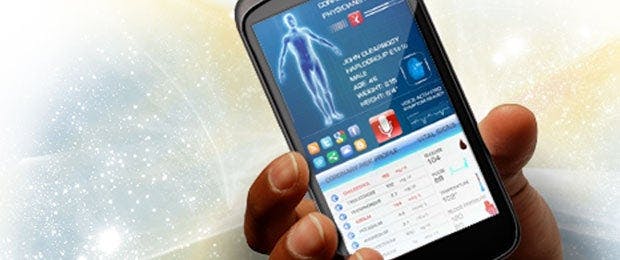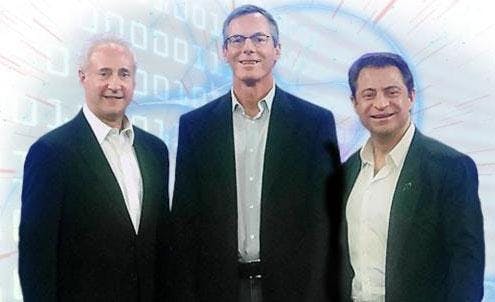Published Oct 10, 2013
$10 Million Qualcomm Tricorder Competition: An Update
$10 Million Qualcomm Tricorder Competition: An Update

StarTrek.com, in June, 2011, reported that, inspired in large part by Star Trek, the not-for-profit organization X PRIZE Foundation and communications giant Qualcomm planned to launch a contest that would ultimately bestow $10 million upon anyone or any team that could develop a practical, lightweight, mobile, real-world version of Star Trek’s fictional Tricorder that everyday folks could use at home, without the presence of a doctor or health care provider, to evaluate health issues. The competition kicked off in 2012 and is well under way, and we thought it was time for update. So, we checked in with Dr. Erik Viirre, Technical and Medical Director for the Qualcomm Tricorder XPRIZE. Here’s what he had to say:

Go back a step. Who actually came up with the great notion of using Star Trek and the Tricorder device as the inspiration for this competition? And how surprised or not were you that CBS Consumer Products was on board with the idea?
DR. VIIRRE: In early December 2010, Peter Diamandis, the chairman and CEO of XPRIZE, met with Don Jones, vice president of global strategy and market development for Qualcomm Life. During these conversations the scope of the prize began to rapidly take form. Don saw how the prize conceptually would lead to development of a device akin to the famous Tricorder, and initiated a meeting with Paul Jacobs, chairman and CEO of Qualcomm and chair of the Qualcomm Foundation. Paul Jacobs immediately saw the potential value of the competition. The Qualcomm Foundation agreed to sponsor the competition, enabling the Tricorder XPRIZE to become a reality, culminating in the launch of the Qualcomm Tricorder XPRIZE at the Consumer Electronics Show in January 2012. Having CBS license the concept and name was a huge boost to the competition because the technology dazzled fans of the show, but the license makes so much sense because of the technological influence of the show and its ideas.
The competition was announced in 2011 and started in 2012. What kind of reaction has it gotten from the scientific community?
DR. VIIRRE: Immediately, upon the discussion of the concept of the prize, there was huge medical, scientific and technological interest. World-renowned medical scientists, clinicians and engineers gathered to put the scope of the project together. Our best example of this interest is the formal announcement by the FDA that they would provide support for our prize. This, along with so many other science and technology partners tells us we are on the cusp of a world-changing event. We know that Trek fans are prevalent in organizations such as NASA, but medical and bioengineering schools are full of fans who wanted to bring Star Trek technology from the 23rd to the 21st century.
To your knowledge, how many companies/teams are vying for the prize? And from how far around the globe are those competitors coming?
DR. VIIRRE: As of today there are 41 registered teams from 9 countries for the competition.
To make this work, the device needs to combine healthcare, mobile and wireless technologies/innovations. So, are you seeing companies actually joining forces to collaborate on this project? Are divisions within companies teaming up? Maybe... both?
DR. VIIRRE: We think that collaboration between corporations, universities and start-ups will be necessary to win the prize. All the requirements are technically feasible right now, but the wide range of capabilities necessary to win means very few, if any, entities will have everything on their own. Collaboration is a must.
What's the timeline from here? Registration is closed, so what are the next steps?
DR. VIIRRE: Teams have to be working diligently right now to be able to compete in the Qualifying Round and the Finals. In the winter of 2014, they will submit documentation of their proposed technologies, how they are going to measure vital signs, assess medical conditions, and wrap all the systems into a useable mobile platform. A huge difference between the Tricorders for the competition and the one in the show is that you won’t need Mr. Spock or Dr. McCoy to understand how to use it. They will be built for the average consumer.
In spring of 2014 a panel of expert judges will review the proposed plans from the teams. Ten finalists will be selected and notified that they can build hardware that will be tested using actual people. Those tests will be done in the winter and spring of 2015.
Can you elaborate more on who will select the winner, and how and when will the winner be chosen?
DR. VIIRRE: The winners will be determined by a scoring system that incorporates how well they did on detecting the 15 different health conditions with the consumer testers and, critically, how easy and straightforward the consumers found the systems use to be. If you build the best technology in the world, but people can’t figure out how to turn it on, then what’s the point? Half of the scoring will be on the user experience. Scores will be tabulated, certified by judges and the winners announced in the summer of 2015.

Take us through getting this into the hands of the consumer. The winner is picked... then what? How does the product advance from prototype to reality? How quickly can that be achieved? And what's your guess as to how to make it affordable to the average person?
DR. VIIRRE: Competing for our prize will take all teams a long way to being able to get the technologies out of their labs and in front of the medical community and general public. Different countries have different regulatory requirements, but because our competition is based in the U.S. and the most important regulator is the FDA, teams will have to carefully determine how to get their systems approved. The FDA is extremely interested in this new area of technology and is an active partner in advising our teams. Some teams will build systems for the U.S. and others for other countries. We hope and strongly advise teams to lay all the groundwork and documentation necessary for regulatory review as they build for the competition. If they take the appropriate advice and get their paperwork done, then they will still have some months of testing and presentations to get the approvals they need after the competition is won. We believe that, like smart phones now, tens of millions of these systems will be sold, even in the first few years. Not only consumers, but governments and insurers will see the enormous improvement in health care that will come from Tricorder-type devices, and these huge numbers will ensure a fair price for everyone.
And, finally, give us YOUR personal Star Trek credentials. How big a fan are you of the franchise? What's your favorite bit of Trek-nology?
DR. VIIRRE: I’m a lifelong fan of Star Trek! I watched TOS when I was in high school and could tell you what episode it was in 10 seconds. I get to carry my own Tricorder now, which I will have XPRIZE technology built into. I’ve met most of the Bridge of 1701C, including Captain Kirk, Mr. Spock, LT. Uhura, and Mr. Sulu. Sadly, I never got to meet DeForest Kelley. However, this year I had engineering students build a replica Sick Bay bed for actual medical research. The Sick Bay monitor that could measure your body function as soon as you lay down on the bed was my favorite, and I am building it!
Click HERE for additional details.
